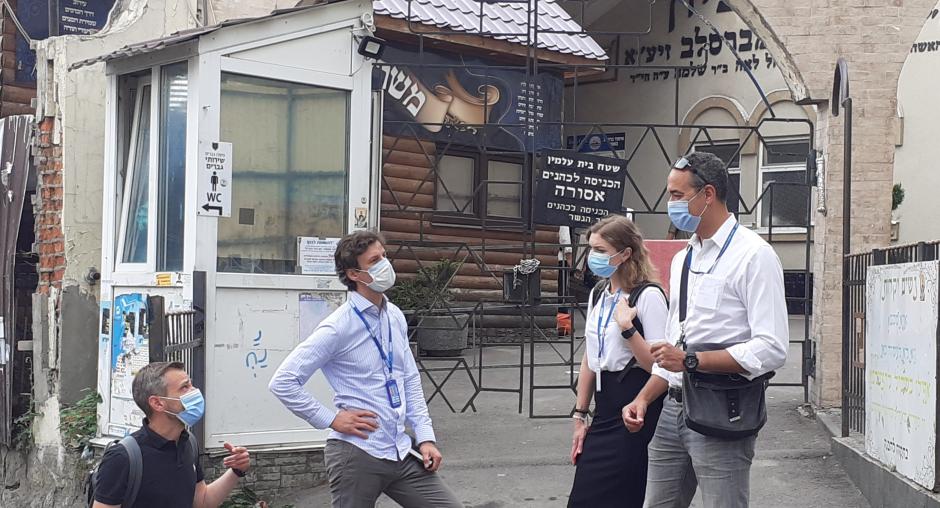Preparing for the Jewish New Year: SMM on Patrol in Uman
The sun is barely up on this Wednesday morning in early August, but Borisa, Team Leader of the SMM’s Monitoring Team in Kyiv, and Yaroslav, the team’s language assistant, are already in the car and on the highway. With them are Pascal from Germany and Mariia from Ukraine who work with the Mission’s Human Dimension Unit. The four-member team is bound for Uman, a city in the southwest of Cherkasy region, halfway between Kyiv and Odessa.
Borisa, who was born in the Bosnian capital of Sarajevo and coordinated UNESCO’s work in the Middle East before joining the SMM, explains the task for today’s patrol. “Every year, Hasidic Jews make the pilgrimage to Uman on the occasion of the Jewish New Year, Rosh Hashanah. Their number has grown continuously. We’ll talk to the city authorities and representatives of the Hasidic community to find out how they are preparing ahead of this year’s celebrations.”
The drive to Uman takes almost three hours. While passing by lush hills, fields of sunflower and sweet corn, Mariia, who is on her first patrol, gets some background information from Yaroslav. After years of working in business consulting, Yaroslav became a translator for the Mission in 2014. He has been to Uman many times and is familiar with the city and its history.
“In the 19th century, Uman was one of the most important spiritual centers of Jewish life in Ukraine. Rabbi Nachman, founder of the Breslov Hasidic movement, died there in 1810. Legend has it that he once told his students, ‘Make sure that you are with me for Rosh Hashanah, no matter what!’ and ever since, pilgrims come to Uman to celebrate the Jewish New Year in his honor.”
The team arrives in Uman and heads to the mayor’s office. Only recently elected, Iryna Pletnova has decided to take on some of the city’s most pressing problems, one of them being infrastructure. “Water supply, waste collection, repairing the municipal roads, that is what I am concerned about, also because it matters a lot to the pilgrims,” Pletnova says, adding that even though things have improved a lot in recent years, there is still a lot of work to be done. “The city has allocated several millions of Hryvnia to ensure that everything is in good shape for Rosh Hashanah.”
As the meeting continues, Mariia asks the mayor about the number of pilgrims that are expected to come this year.
“You need to keep in mind that this is the largest gathering of foreigners in all of Ukraine,” Mayor Pletnova says. “Most pilgrims are from Israel. Others come from the United States, Canada and various countries of Europe. In 2019, Uman hosted almost 27,000 pilgrims. In 2020, they could not come because of COVID-19 restrictions. So this year, we expect up to 50,000 people.”
After an hour of conversation, Borisa, Yaroslav, Pascal and Mariia thank Uman’s mayor for her time and say their goodbyes. They decide to leave the car parked and walk to their meeting with the representatives of the Rabbi Nachman Foundation. Strolling down the streets, sidelined by picturesque houses dating back to the turn of the twentieth century, feels like traveling back in time.
Some 20 minutes later, they reach Uman’s Jewish quarter. With kids playing football in the yards, dogs barking and laundry drying in the summer sun, this little side street does not look different from other streets in the city except for all of the shops and restaurants have signs and advertisements out front in the Hebrew alphabet.
The team arrives at the offices of the Rabbi Nachman Foundation where the director, Nathan Ben-Nun, greets them at the entrance. “Allow me to explain the meaning that Rabbi Nachman’s teachings have for us,” Ben-Nun begins. “According to his philosophy, believers should speak to God in simple language, as they would to a friend. That is one of the reasons why he became an acclaimed spiritual leader and why followers of the Breslov Hasidic movement gather at his grave for Rosh Hashanah.”
Still, Ben-Nun is aware that the Hasidic community faces some worldly problems during the time of the pilgrimage. “The infrastructure of Uman was never planned to meet the needs of so many people. That is why, during the days of Rosh Hashanah, water supply and waste collection pose a challenge.”
Just like Uman’s mayor Pletnova, Ben-Nun acknowledges that progress has been made over the past years. “At the time of Rosh Hashanah, both the Jewish community and the city’s authorities work at full capacity to accommodate the needs of the local population and the pilgrims,” he says with certainty. “However, the lines of communication between the parties involved are sometimes not quite clear.” Pascal, a German monitor with over 20 years of experience in international organizations, suggests Ben-Nun to meet again, in order to discuss the topic further.
With the meeting coming to an end, the SMM’s team and Ben-Nun agree to stay in close contact over the coming weeks. As the team walk back to their car to start the return journey to Kyiv, Borisa shakes his head in disbelief. “It is hard to imagine that this place will be buzzing with tens of thousands of pilgrims any day now.” And with a smile, Mariia adds “I guess this means that we will be back soon.”

